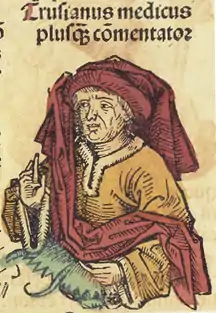Turisanus
Turisanus de Turisanis[1] was the Latin name of Pietro Torrigiano de' Torrigiani (died c. 1320), a theoretical physician[2] from a well-known Florentine family[3] who taught medicine in Paris, c. 1305–19,[4] and wrote an elaborated and influential[5] series of commentaries on Galen's Microtechni, Plusquam commentum in Microtechni Galenii and a shorter De hypostasi urine Galeni. The two commentaries, all that survives of Torrigiani's output, were printed together by Ugo Rugerius[6] in 1489, and in several later editions, both incunabula and 16th-century printings. The work took the conventional form of the set of quaestiones disputatae familiar in Scholasticism.

He was trained in the famed medical school of Bologna as a pupil of the Florentine Taddeo Alderotti (Thaddeus Florentinus). In his old age he retired to a Carthusian monastery, thus he is referred to a Monachus.[7]
He was the first medieval physician to propose an original theory about blood and its role in the human system.
Notes
- He is also known as Turisanus Monac[h]us ("Torrigiano the Monk"), Drusianus or Trusianus.
- Brian Lawn, Rise and decline of the scholastic Quaestio disputata (Brill, 1993), p. 72, doubts he ever practiced.
- He is Turisanus Florentinus in the printed edition under the title Plusquam commentum in parvam Galeni artem (Venice, 1557), noted by Roger Kenneth French, Ancients and Moderns in the Medical Sciences: from Hippocrates to Harvey" Bulletin of the History of Medicine 75.4, Winter 2001 p. 450, note 15).
- Lawn 1993, p 72, noting Ottosson, p. 45ff.
- Lawn (1993 p. 73) notes that Gentile da Foligno wrote a set of Quaestiones simply to criticize Torrigiani's teachings on certain points.
- Ugo Rugerius (Ugo Ruggeri) was a peripatetic printer from Reggio di Modena in the first age of printed books: according to his title pages, he printed at Venice at various dates from 1474-93, at Reggio di Modena (1478), Pisa (1494) and Bologna 1495-99; a single work is dated from San Cesario, 1499 (Frederick John Norton, Italian printers, 1501-1520: an annotated list).
- The Catholic Encyclopedia, s.v. "Medicine".
